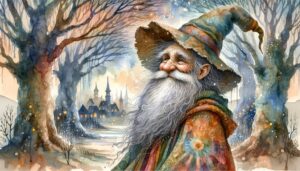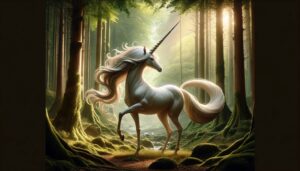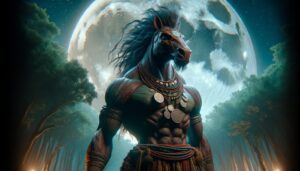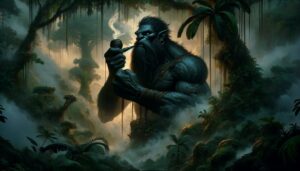Table of Contents
In the tapestry of Philippine mythology, nestled amid the lush foliage of the archipelago’s diverse landscapes, there exists a creature of unparalleled mystique and intrigue – the enigmatic Berberoka.
Origins and Lineage
The origins of the Berberoka remain as murky as the waters they call home. This aquatic entity emerges from the rich tapestry of Filipino folklore and has deep roots in the animistic beliefs of the indigenous peoples of the Philippines. Although not considered a deity per se, people view the Berberoka as a spiritual being closely linked to the natural world, particularly the rivers and bodies of water that intersect the archipelago.
In the annals of Philippine mythology, the Berberoka frequently connects with the diwata, benevolent forest spirits, and elemental beings known as anitos. This affiliation underscores the creature’s intrinsic connection to the delicate balance between the earthly and the supernatural realms. Furthermore, it serves as a testament to the cultural amalgamation that has shaped the Philippines, where indigenous beliefs intertwine with the impact of Spanish colonization and Christianization.
Appearance

The Berberoka is a mythical creature from Filipino folklore, specifically from the Visayan region of the Philippines. People often describe it as a beautiful and seductive mermaid-like creature that dwells in freshwater bodies like rivers, lakes, and ponds. A Berberoka’s appearance may vary in different accounts, but it typically encompasses the following traits:
Its upper body typically resembles that of a stunningly attractive woman, featuring long, flowing hair, enchanting eyes, and an alluring voice that it employs to entice unsuspecting victims.
Lower Body: Below the waist, the Berberoka has the body of a large fish or serpent, similar to a mermaid. This aquatic lower body allows her to swim gracefully in the water.
The Berberoka often possesses scales covering her lower body, which can be colorful and iridescent. She may also wields fins, akin to those of a fish, which aid her in navigating the water.
Berberokas are renowned for their supernatural abilities, such as the power to control water and generate strong currents. They employ these powers to ensnare and drown their prey.
Despite their beauty, people consider Berberokas dangerous and malevolent creatures. They employ their looks and enchanting songs to seduce and ensnare humans, pulling them beneath the water to their deaths.
Certain versions of the folklore attribute to Berberokas the ability to shapeshift into various forms, including that of a beautiful woman or even an ordinary fish.
Abilities
Berberokas are known for their beautiful and enchanting songs, and they employ their melodious voices to entice unsuspecting humans who are drawn to their music.
Hypnotic Gaze: Some versions of the folklore suggest that Berberokas have a mesmerizing gaze that can hypnotize and captivate their victims, making it easier to lure them into the water.
Shape-shifting: In certain versions of the folklore, Berberokas have the ability to change their appearance. They can transform into beautiful women or even take on the appearance of ordinary fish to disguise themselves.
Water Manipulation: Berberokas are believed to have control over water and can create strong currents or whirlpools in rivers, lakes, and ponds. They use this power to trap and drown their victims.
Invisibility: Some accounts describe Berberokas as being able to become invisible at will, making it even more challenging for humans to detect their presence until it’s too late.
Similar to sirens in mythology, Berberokas employ their beauty, charm, and alluring presence to lure humans closer to the water, where they can trap them.
Some people believe that Berberokas have the power to curse those who offend or harm them. They may inflict misfortune or calamity upon those who cross their path.
Symbols and Significance
In the realm of symbolism, the Berberoka embodies the dualities of beauty and danger, allure and peril, and the profound connection between humanity and nature. Furthermore, her association with water underscores the vital importance of rivers and seas in Filipino culture, as these bodies of water have historically been the lifeblood of the archipelago.
The iridescent scales that adorn her serpentine tail symbolize the ever-changing and unpredictable nature of water, while her mesmerizing songs evoke the allure of the unknown, enticing mortals to explore the mysteries of the deep. The Berberoka serves as a reminder of the fragile equilibrium between humans and the natural world, urging respect and reverence for the environment.
Myths and Stories

The tales of Berberoka are as diverse as the regions of the Philippines themselves, each bearing a unique cultural imprint. One prevalent myth tells of a brave fisherman who, while out at sea, encountered the beguiling Berberoka. Enchanted by her beauty and entranced by her song, he followed her into the depths, never to be seen again. This story serves as a cautionary tale, warning against the temptations of the unknown and the perils that lurk beneath the surface.
Another story tells us that people can appease and even befriend the Berberoka when they show respect for the waters and the creatures that inhabit them. Furthermore, these narratives depict her as a guardian of the rivers and seas, securing the prosperity of fisherfolk and the abundance of marine life. This version of the Berberoka emphasizes her dual nature – a being of beauty and benevolence when treated with reverence.
Cultural Impact and Thematic Exploration
The Berberoka’s presence extends beyond the realm of folklore, permeating various aspects of Philippine culture and society. Furthermore, her character is often used as a symbol of the mystical and enchanting aspects of the archipelago, inspiring literature, art, and even modern media. Additionally, her allure and danger continue to captivate the imagination of writers and artists, who explore themes of temptation, the supernatural, and the fragile harmony between humanity and nature.
Furthermore, the Berberoka serves as a reminder of the Philippines’ rich cultural tapestry, where indigenous beliefs, colonial influences, and modern sensibilities coexist. She symbolizes the enduring connection between the Filipino people and their natural surroundings, emphasizing the need for environmental stewardship in a rapidly changing world.
Conclusion
In the realm of Philippine mythology, the Berberoka stands as a tantalizing embodiment of the deep, mysterious waters that cradle the archipelago. Her beauty, allure, and power to command the currents and tides have fueled countless tales and legends, thus reflecting the complex relationship between humanity and the natural world.
As a Mythical Explorer, I have unveiled the layers of the Berberoka’s mythology. I have traced her origins, explored her abilities, and delved into her cultural significance. This enigmatic water spirit, with her dual nature of beauty and peril, serves as a poignant symbol of the Philippines’ rich cultural heritage. Furthermore, it represents the enduring connection between the people and the waters that sustain them. The Berberoka remains a timeless reminder of the delicate balance between the mystical and the mundane, the known and the unknown, in the heart of the Philippines.
FAQ
What does a Berberoka look like?
It is often described as a giant fish with sharp teeth and a long tongue.
Where is the Berberoka said to live?
It is said to live in the deep rivers and lakes of the Philippines.
Is the Berberoka friendly or dangerous?
It is considered dangerous and is known for devouring humans.
Are there any famous stories involving the Berberoka?
Yes, there are legends of brave individuals defeating the Berberoka to protect their communities.
Does the Berberoka have any special abilities?
It is known for its strength and ability to create whirlpools to trap its prey.
Is the Berberoka still believed in today?
It is mainly a part of folklore and mythology, but some people may still believe in its existence.
Are there any rituals or practices associated with the Berberoka?
Some communities have rituals and offerings to appease the creature and seek protection.
How has the Berberoka been represented in Filipino culture?
It has appeared in various forms of art, literature, and storytelling in Filipino culture.
Can the Berberoka be found in other countries?
No, it is a creature unique to Filipino folklore and mythology.




